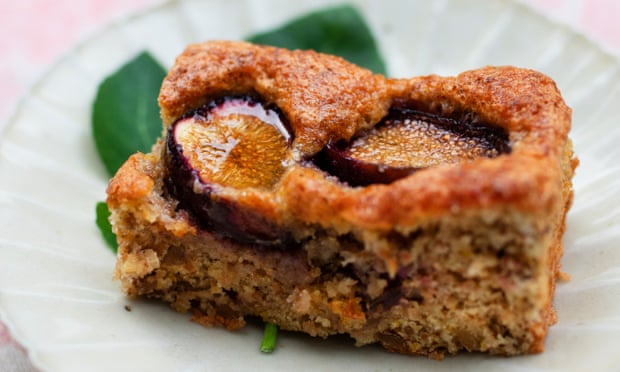
Should we get rid of the marrow? I am not entirely sure what possessed me to bring it home, perhaps a fit of nostalgia for the harvest festival where the least-loved squash and its pale green and cream stripes would sit among bunches of carnival-coloured dahlias on the church’s stone windowsill. Whatever the reason, it is still in the fridge and beginning to haunt me.
I am less ambivalent than most about the last of the green-fleshed summer squash. The flesh sponges up garlic, herbs and pan juices deliciously and when left to fry until golden, the edges will (eventually) caramelise sweetly enough. They are cheap – I bought mine for less than £1 – and all too often appear in the weekly late-summer vegetable delivery box. Even peeled and seeded there is a lot of flesh in a 1kg marrow. I found it likes miso, too. I will get a couple of good dinners out of mine, the first with minced pork, the second as a gratin, under a nostalgic blanket of parmesan-crusted cheese sauce.
I am still being bombarded by figs, both from the little tree in the garden, and in the local shops where their price has come down considerably over the last few weeks. Making the most of them this week, I pushed them down into the batter of a scrunchy walnut cake, which I then served as dessert, trickled with runny honey.
Pork, miso and marrow
If you move the marrow around the pan, it will never brown and you’ll end up with jam, so only turn each piece with kitchen tongs as the underside starts to colour. Please don’t forget the lime – it’s crucial to the balance of the dish. Serves 2, heartily
marrow 500g, or 400g of courgette
groundnut oil 4 tbsp, plus a little extra
shallot 1 large, finely chopped
garlic 2 cloves, finely chopped
ginger 50g, grated to a fine pulp
red chilli 1, seeded and finely chopped
minced pork 450g
brown miso paste 1 tbsp
rice wine vinegar 2 tbsp
stock 100ml (you can use water at a push)
sesame seeds 2 tbsp
coriander leaves a small handful
lime 1
Peel the marrow, slice it in half lengthways and scoop out and discard the spongy bit in the middle. Cut the flesh into slices about 1cm thick and then in half again. (If you are using courgettes there is no need to peel them or to remove the core.)
Warm the oil in a wide shallow pan – I use one 28cm in diameter. A frying pan or wok will do nicely. Then, when it is hot, add the marrow. Let the pieces fry for 7-8 minutes over a fairly high heat without moving them round the pan, until they are tender and patchily golden underneath. Turn each one over with kitchen tongs and let the other side colour, too – a further 3 or 4 minutes. Remove the marrow from the pan with a draining spoon, set aside in a bowl and cover with a lid, so they continue softening in their own steam. (Courgettes may take slightly less cooking time.)
While the marrow cooks, peel and finely chop the shallot and garlic. Peel the ginger and grate to a thick pulp on a fine grater. Halve, seed and finely chop the chilli.
Replace the pan on the heat and add a little more oil – you don’t need much, just 1 tbsp or so to give a thin film – then add the shallot, garlic, ginger and chilli. This time, move everything round the pan as it cooks for a minute or two, so it does not burn. Turn the heat up, add the pork, flattening it slightly as you go. Leave to cook, without moving anything, for 6 or 7 minutes, maybe longer, until the pork is golden underneath. Once the pork has formed a good brown crust underneath, break it up, stirring lightly, and leave it to cook for another couple of minutes.
Stir in the miso paste and the rice vinegar (but no salt or pepper) and then the stock. Return the marrow to the pan, continue cooking, with the occasional stir, for 2 minutes until all is bubbling. Scatter over the sesame and coriander and spoon into shallow bowls. Squeeze the lime over each before eating.
Walnut and fig cake
A soft and nutty cake to serve for tea or as a dessert with a jug of cream or chilled custard. Serves 12-16
eggs 6
golden caster sugar 150g
shelled walnuts 100g
ground almonds 100g
self-raising flour 100g
breadcrumbs 50g, fresh, white
green cardamom pods 10
orange grated finely zest of 1
orange juice 75ml
figs 6, medium
honey 100ml
Line the base and sides of a 20 x 20cm square cake tin with a piece of baking parchment. Preheat the oven to 180C/gas mark 4.
Separate the eggs, putting the whites into a large mixing bowl and the yolks into the bowl of an electric mixer fitted with a whisk attachment. Add the caster sugar to the yolks and beat until pale and thick. You can expect this to take a good 5 minutes.
Chop the walnuts. For ease and speed you can do this in the food processor, but take care not to reduce it to fine crumbs – they should still have a coarse texture. Mix the walnuts with the ground almonds, breadcrumbs and then the flour.
Crack open the cardamom pods and extract the seeds. Grind to a powder with a pestle and mortar or spice mill. Add to the nuts, then add the orange zest.
Squeeze the orange juice into a small bowl, then mix into the beaten egg yolk and sugar. Using a balloon whisk, beat the egg whites until almost stiff. Fold the chopped nut mixture into the yolk and sugar mixture, then tenderly but thoroughly stir in the egg whites. (There should be no lumps of unmixed egg white in the mixture, but take care not to overmix and knock the air out.) Transfer the batter to the lined baking tin.
Halve the figs and push them, cut side up, into the cake batter. Bake for 30-35 minutes, until the sponge is soft and springy.
Warm the honey in a small saucepan. Remove the cake from the oven and pierce in about 20 places with a metal skewer, then pour the liquid honey over the cake, letting it run into the holes. Set aside for 15 minutes for the cake to settle.
Follow Nigel on Instagram @NigelSlater



